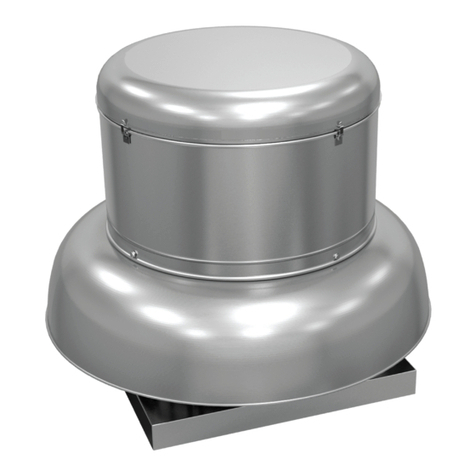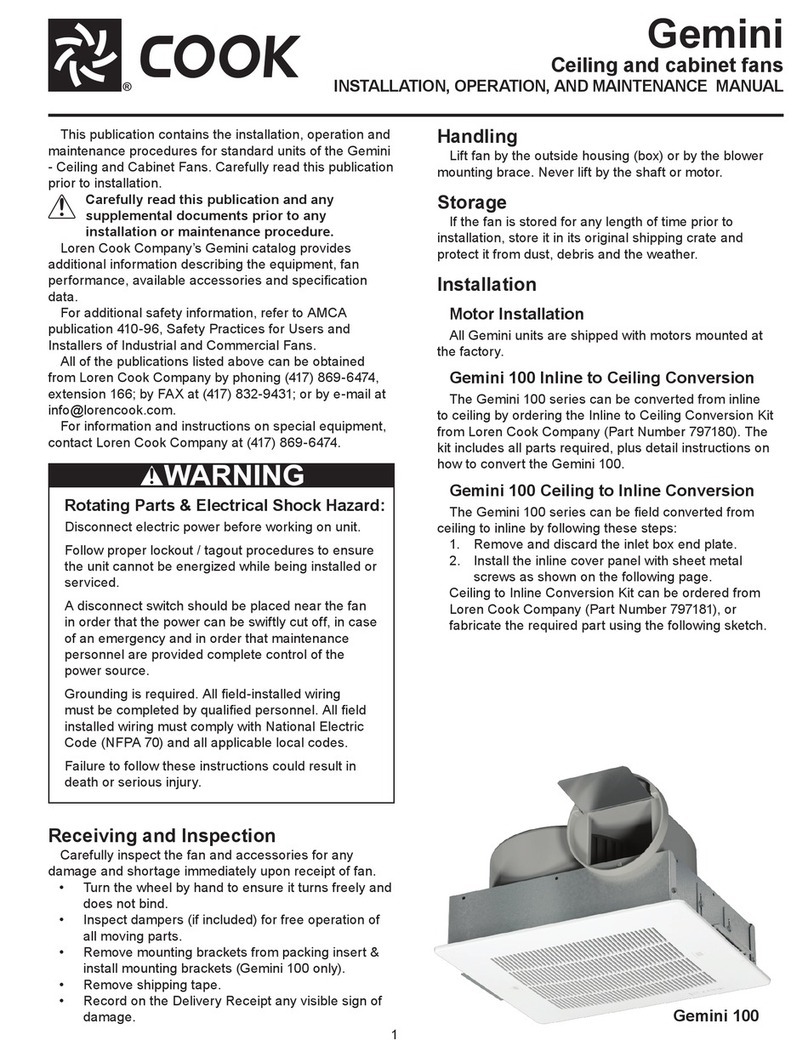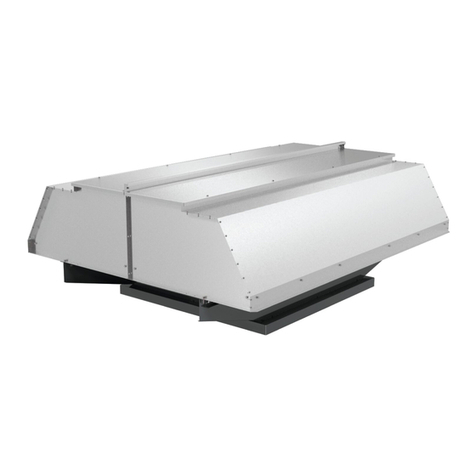
4CV IO&M B51161-003
Bearings should be relubricated in accordance with the
conditions chart below.
Conditions Chart
RPM Temp °F Greasing Interval
Up to 1000 -30 to 120 6 months
120 to 200 2 months
1000 to 3000 -30 to 120 3 months
120 to 200 1 month
Over 3000 -30 to 120 1 month
120 to 200 2 weeks
Any Speed < -30 Consult Factory
Any Speed > 200 1 week
For moist or otherwise contaminated installations; divide the in-
terval by a factor of three. For vertical shaft installations divide
the interval by a factor of two.
For best results, lubricate the bearing while the fan is in
operation. Pump grease in slowly until a slight bead forms
around the bearing seals. Excessive grease can damage
seal and reduce life through excess contamination and/or
loss of lubricant.
In the event that the bearing cannot be seen, use no more
than three injections with a hand operated grease gun.
Motor Bearings
Motors are provided with prelubricated bearings. Any
lubrication instructions shown on the motor nameplate su-
persede instructions below.
Direct Drive 1050/1075, 1200, 1300 & 1500 RPM units
use a prelubricated sleeve bearing that has a oil saturated
wicking material surrounding it. The initial factory lubrica-
tion is adequate for up to 10 years of operation under nor-
mal conditions. However, it is advisable to add lubricant
after three years. Use only LIGHT grade mineral oil or SAE
10W oil up to 30 drops.
If the unit has been stored for a year or more it is ad-
visable to lubricate as directed above. For units in severe
conditions, lubrication intervals should be reduced to half.
Motors without sleeve bearings (as described above) will
have grease lubricated ball or roller bearings. Motor bear-
ings without provisions for relubrication will operate up to
10 years under normal conditions with no maintenance. In
severe applications, high temperatures or excessive con-
taminates, it is advisable to have the maintenance depart-
ment disassemble and lubricate the bearings after 3 years
of operation to prevent interruption of service.
For motors with provisions for relubrication, follow inter-
vals of the table below.
Relubrication Intervals
Service
Conditions
Nema Frame Size
Up to and
Including 184T 213T-365T 404T and Larger
1800
RPM
and
Less
Over
1800
RPM
1800
RPM
and
Less
Over
1800
RPM
1800 RPM
and Less
Over
1800
RPM
Standard 3 yrs. 6 months 2 yrs. 6 months 1 yr. 3 months
Severe 1 yr. 3 months 1 yr. 3 months 6 months 1 month
Motors are provided with a polyurea mineral oil NGLI #2
grease. All additions to the motor bearings are to be with
a compatible grease such as Exxon Mobil Polyrex EM and
Chevron SRI.
The above intervals should be reduced to half for vertical
shaft installations.
Inspection
Inspection of the fan should be conducted at the rst 30
minute, 8 hour and 24 hour intervals of satisfactory op-
eration. During the inspections, stop the fan and inspect as
per the following directions.
30 Minute Interval
Inspect bolts, setscrews, and motor mounting bolts. Ad-
just and tighten as necessary.
8 Hour Interval
Inspect belt alignment and tension. Adjust and tighten as
necessary.
24 Hour Interval
Inspect belt tension. Adjust and tighten as necessary.
Maintenance
Establish a schedule for inspecting all parts of the fan.
The frequency of inspection depends on the operating
conditions and location of the fan.
Inspect fans exhausting corrosive or contaminated air
within the rst month of operation. Fans exhausting con-
taminated air (airborne abrasives) should be inspected ev-
ery three months. Clean the propeller and air inlets if ma-
terial build-up is excessive. Excessive build-up can cause
imbalance and failure of the propeller. Regular inspections
are recommended for fans exhausting non-contaminated
air. It is recommended the following inspections be
conducted twice per year.
• Inspect bolts and setscrews for tightness. Tighten as
necessary
• Inspect belt wear and alignment. Replace worn belts with new
belts and adjust alignment as needed. See Belt and Pulley
Installation, page 2
• Bearings should be inspected as recommended in the
Conditions Chart
• Inspect for cleanliness. Clean exterior surfaces only.
Removing dust and grease on motor housing assures proper
motor cooling
Lubricants
Loren Cook Company uses petroleum lubricant in a lith-
ium base conforming to NLGI grade 2 consistency. Other
grades of grease should not be used unless the bearings
and lines have been ushed clean. If another grade of
grease is used, it should be lithium-based.
An NLGI grade 2 grease is a light viscosity, low-torque,
rust-inhibiting lubricant that is water resistant. Its tempera-
ture range is from -30°F to +200°F and capable of intermit-
tent highs of +250°F.
Fan Bearings
The fan bearings are provided prelubricated. Any spe-
cialized lubrication instructions on fan labels supersedes
information provided herein. Bearing grease is a petroleum
lubricant in a lithium base conforming to an NLGI #2 con-
sistency. If user desires to utilize another type of lubricant,
they take responsibility for ushing bearings and lines, and
maintaining a lubricant that is compatible with the installa-
tion.
An NLGI #2 grease is a light viscosity, low-torque, rust-
inhibiting lubricant that is water resistant. Its temperature
range is from -30°F to 200°F and capable of intermittent
highs of 250°F.






























